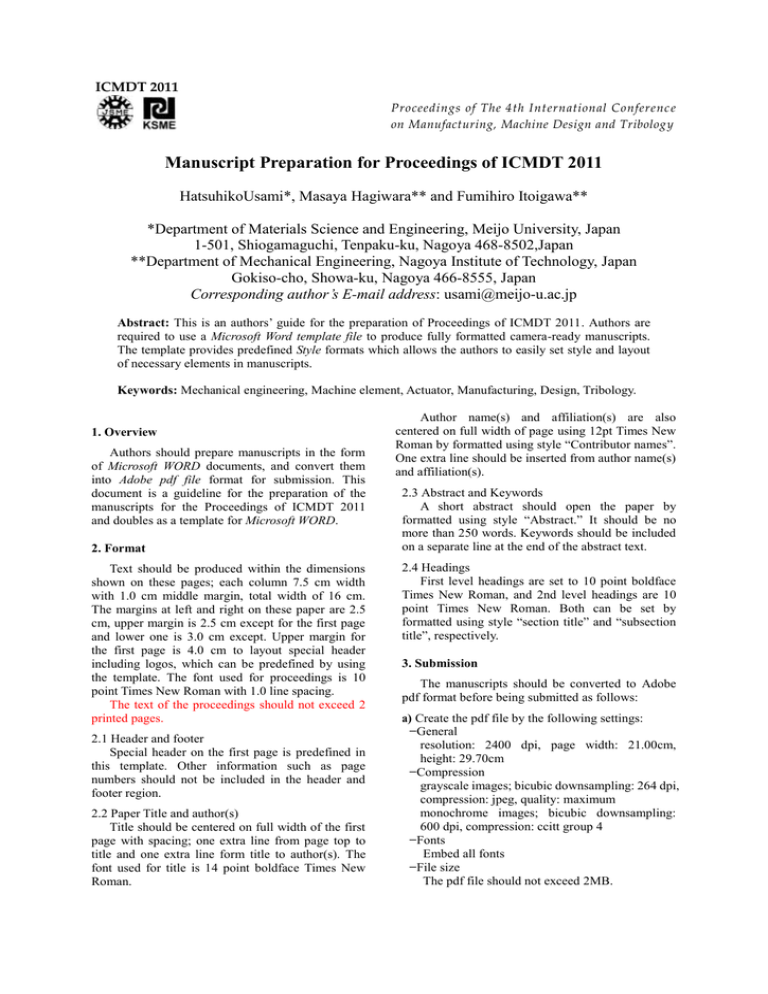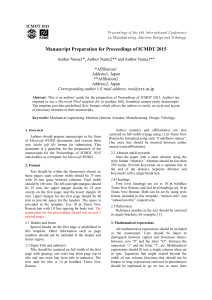Manuscript Preparation for Proceedings of ICMDT 2011
advertisement

ICMDT 2011 Proceedings of The 4th International Conferenc e on Manufacturing, Machine Design and Tribology Manuscript Preparation for Proceedings of ICMDT 2011 HatsuhikoUsami*, Masaya Hagiwara** and Fumihiro Itoigawa** *Department of Materials Science and Engineering, Meijo University, Japan 1-501, Shiogamaguchi, Tenpaku-ku, Nagoya 468-8502,Japan **Department of Mechanical Engineering, Nagoya Institute of Technology, Japan Gokiso-cho, Showa-ku, Nagoya 466-8555, Japan Corresponding author’s E-mail address: usami@meijo-u.ac.jp Abstract: This is an authors’ guide for the preparation of Proceedings of ICMDT 2011. Authors are required to use a Microsoft Word template file to produce fully formatted camera-ready manuscripts. The template provides predefined Style formats which allows the authors to easily set style and layout of necessary elements in manuscripts. Keywords: Mechanical engineering, Machine element, Actuator, Manufacturing, Design, Tribology. 1. Overview Authors should prepare manuscripts in the form of Microsoft WORD documents, and convert them into Adobe pdf file format for submission. This document is a guideline for the preparation of the manuscripts for the Proceedings of ICMDT 2011 and doubles as a template for Microsoft WORD. 2. Format Text should be produced within the dimensions shown on these pages; each column 7.5 cm width with 1.0 cm middle margin, total width of 16 cm. The margins at left and right on these paper are 2.5 cm, upper margin is 2.5 cm except for the first page and lower one is 3.0 cm except. Upper margin for the first page is 4.0 cm to layout special header including logos, which can be predefined by using the template. The font used for proceedings is 10 point Times New Roman with 1.0 line spacing. The text of the proceedings should not exceed 2 printed pages. 2.1 Header and footer Special header on the first page is predefined in this template. Other information such as page numbers should not be included in the header and footer region. 2.2 Paper Title and author(s) Title should be centered on full width of the first page with spacing; one extra line from page top to title and one extra line form title to author(s). The font used for title is 14 point boldface Times New Roman. Author name(s) and affiliation(s) are also centered on full width of page using 12pt Times New Roman by formatted using style “Contributor names”. One extra line should be inserted from author name(s) and affiliation(s). 2.3 Abstract and Keywords A short abstract should open the paper by formatted using style “Abstract.” It should be no more than 250 words. Keywords should be included on a separate line at the end of the abstract text. 2.4 Headings First level headings are set to 10 point boldface Times New Roman, and 2nd level headings are 10 point Times New Roman. Both can be set by formatted using style “section title” and “subsection title”, respectively. 3. Submission The manuscripts should be converted to Adobe pdf format before being submitted as follows: a) Create the pdf file by the following settings: −General resolution: 2400 dpi, page width: 21.00cm, height: 29.70cm −Compression grayscale images; bicubic downsampling: 264 dpi, compression: jpeg, quality: maximum monochrome images; bicubic downsampling: 600 dpi, compression: ccitt group 4 −Fonts Embed all fonts −File size The pdf file should not exceed 2MB. b) Submit the pdf file no later than March 5, 2011 by e-mail as: −File name “Registration No”+“First author’s family name” (e.g., 105usami.pdf) −Mailing address usami@meijo-u.ac.jp Max. 220 mm Max. 70 mm 4. Mathematical expressions All mathematical expressions should be included in the manuscript. Care should be taken to distinguish between capital and lowercase letters, between zero “0” and the letter “O”, between the numerical “1” and the letter “l”, etc. Mathematical expressions should fit into a single column when set in type. Equations that might extend beyond the width of one column (fractions that should not be broken or long expressions enclosed in parentheses) should be rephrased to go on two or more lines within column width. Fractional powers are preferred to root signs and should always be used in more elaborate formulas. The solidus “/” should be used instead of the horizontal line for fractions whenever possible. Numbers that identify mathematical expressions should be enclosed in parentheses. Refer to equations in the text as "Eq. (1)", or "Equation (1)" at the beginning of a sentence. h x 3 p h x y 3 p 6u h (1) y x Fig.1 One-column illustration Ensure that line weights will be 0.5 point or greater in the final published size. Line weights below 0.5 points will reproduce poorly. Set the graphic for 600dpi resolution for line art, 264 dpi for halftones, and 600 dpi for combinations (line art + halftone). 6. Tables All tables should be numbered consecutively and have a caption consisting of the table number and a brief title. This number should be used when referring to the table in text. Tables may be inserted as part of the text, or included on a separate page immediately following of as close as possible to its first reference. Final published size: Single-column table = 70 mm (width), 220 mm (maximum length); Two0column table (full page width) = 155 mm width, 220 mm (maximum length). 7. References 5. Graphics [1] Only balck and white images of PostScript (PS), Encapsulated PostScript (EPS, using either Arial or Times Roman fonts), TIFF(lzw compressed), jpeg and Bitmap files can be accepted. It is important that the following instructions be followed precisely for the graphics files to be utilized in the proceedings. Final published size: single-column illustration = 70 mm (width), 220 mm (maximum length); two-column illustration (full page width) = 155mm width, 220 mm (maximum length). [2] [3] [4] Ning, X., and Lovell, M. R., “On the Sliding Friction Characteristics of Unidirectional Continuous FRP Composites,” ASME J. Tribol., 124(1) (2002) pp. 5-13. Smith, A. C., Lubrication Mechanism, U.S. Patent 9876543 (1990) Barnes, M., “Stress in Solenoids,” J. Appl. Phys., 48(5) (2001) pp. 2000-2008. Jones, J., Contact Mechanics, Cambridge University Press, Cambridge, UK, Chap. 6 (2000). Max. 220 mm Max. 150 mm Fig.2 Two-column illustration


